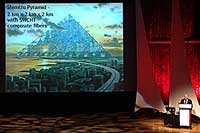Feb 26 2008
Dr. Clayton Teague, the director of the US National Nanotechnology Inititive was warmly welcomed to the ICONN2008 event in Melbourne Australia where he delivered the plenary lecture.
 Shimuzu pyramid the worlds largest building will rely upon carbon nanotubes to become a reality
Shimuzu pyramid the worlds largest building will rely upon carbon nanotubes to become a reality
In his presentation Dr. Teague analysed where Nanotech is now and where it is going.
The underlying strength of the market was emphasised by the ongoing amounts of US nanotech investment but was reinforced by the stated intention of Russia to invest over 1.5 Billion dollars in Nanotech.
Current applications highlighted by Dr. Teague were:
- Nanotech battery powered power tools
- Lightweight cycles
- Iin vivo imaging
- Biocompatible nano material bone screws
- Zero valent nano-iron for the cleanup of trichloroethylene
With one of the most significant developments being the work conducted by a team from MIT who have used self assembling polypetides in body fluids to allow the regrowth of nerve cells. Dr Teague showed the example of a mouse with a severed spinal chord that regained use of it's rear legs following treatement. Other examples included mice regaining sight after being blinded through nerve damage.
Moving into the future Dr. Teague highlighted the following areas he felt nanotechnology would have the greatest impact:
- Energy
- Lighting
- Carbon Nanotubes
- Transportion
- Self Assembling Meta Materials
- Complex Nanostructures
- Health and Safety Challenge
Energy
Nanotechnology is expected to impact upon all sectors of the energy industry from production to transmission, transformation, storage and use. Renewables in the US now accounts for 5-6% of all energy usage, nuclear 8% leaving the rest as hydrocarbon based fuels. The total efficiency of energy usage in the USA is currently 35%. Dr. Teagues view is that "Somehow, someway, Nanotech can contribute to improving our renewable energy usage". In the solar cell area the current state of the art is efficiencies of 14% at $100/msq the target is to move to 20% efficiency at $1/sqm.
Lighting
In the USA 20% of electrical energy goes into lighting. Each 1% reduction in usage is equivalent to taking off line a 5 Gw power plant. Nanobased LED’s can have an efficiency of 50%, projecting forwards this could lead to a reduction of fifty 1 GW power plants, equal to all the nuclear power plants in USA (efficient moves from 25%-50%).
Carbon Nanotubes
Dr Teague stated that Single Walled Carbon Nanotubes (SWCNTs) have "magic properties" with 100 times the tensile strength of steel but only one sixth the mass. SWCNTs also have the high current carrying capcity of copper with a fraction of the mass plus a thermal conductivity similar to diamond. Dr Teague also outlined the possiblities offered by the Shimizu pyramid.
The Shimizu TRY 2004 Mega-City Pyramid is a proposed construction project that cannot be made using currently available materials because they are simply too heavy. The massive pyramid would encase an entire city of 750000 people, answer Tokyo's lack of space, be 12 times higher than the Great Pyramid at Giza and would also be the largest man made structure on Earth. Construction of the 2km x 2km x 2km structure relies on the future availability of super-strong lightweight materials based on carbon nanotubes.
Transportion
The Automobile X-prize is targeting a vehicle which can drive for 100 miles on a single gallon of gas. This needs lightweight vehicles, with an estimated curb weight of 750lb. Is it possible? According to Dr Teague it's all in the materials and getting the costs to the right level. Currently low price MWCNT's cost around 25c/g or $250 /kg. For high purity SWCNT costs are around $1 million /kg. For materials to be successfully adopted in automobiles they need to be available at $4/kg.
Self Assembly of Meta Materials
Nanotechnology is allowing the development of amazing new materials with properties straight from the pages of science fiction. These include materials based on PbSe quantum dots and Fe203 magnetic nanocrystals in ordered superlattice. This material has a negative index of refraction which can be applied to hyperlenses and materials with "cloaking" possibliities.
Complex Nanostructure
US Researchers are now working on biologic nanodevices based on dendrimers that perform multiple functions, i.e. recognise cancer cells, diagnose the cause, deliver drugs to target, report location of tumour and report the outcome.
Major Health and Safety Challenge
In the final segment of his talk Dr. Teague acknowledged the importance of Safe Nanotechnoloy. “Understanding the EHS and risks of these materials is becoming a crucial issue. The US does not want Nanotechnology to be another GMO”